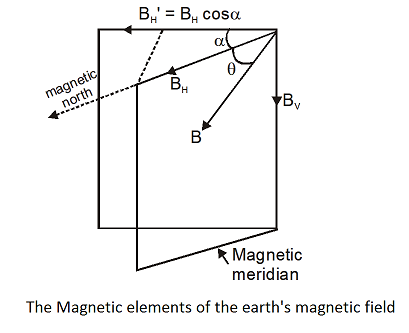
Earth’s magnetic field always has a horizontal component except at
A. Magnetic equator
B. Magnetic pole
C. Geographic north pole
D. At the latitude of ${{45}^{0}}$
Answer
575.4k+ views
Hint: The earth’s magnetic field will have a horizontal component when the magnetic field lines are not perpendicular to the surface of the earth. The direction of the magnetic field at a point is given by the tangent to the magnetic field lines at that point. If the tangent to the field lines is perpendicular to the surface, the magnetic field will also be completely perpendicular to the surface and have no horizontal component.
Complete answer:
The direction of the earth’s magnetic field at a point is given by the tangent to the magnetic field lines at that point. If the tangent is not perpendicular to the surface of the earth at that point, the magnetic field will have a component along the surface of the earth. This component is known as the horizontal component of the earth’s magnetic field at that point.

At the magnetic poles, the magnetic field lines are completely perpendicular to the surface of the earth and so is the tangent to the field lines. Therefore, the direction of the magnetic field at the magnetic poles is completely perpendicular to the surface of the earth and hence, has no component that is parallel to the surface of the earth. Therefore, the horizontal component of the earth’s magnetic field is zero at the magnetic poles.
Hence, Earth’s magnetic field always has a horizontal component except at the magnetic poles where it is zero.
So, the correct answer is “Option B”.
Note:
Students often think that the magnetic poles and the geographic poles on the earth are equal. However, there is a difference in their respective positions and hence even at the geographical poles, the magnetic field has some horizontal component. Students should not confuse between the geographical and the magnetic poles and be aware of this concept.
Complete answer:
The direction of the earth’s magnetic field at a point is given by the tangent to the magnetic field lines at that point. If the tangent is not perpendicular to the surface of the earth at that point, the magnetic field will have a component along the surface of the earth. This component is known as the horizontal component of the earth’s magnetic field at that point.

At the magnetic poles, the magnetic field lines are completely perpendicular to the surface of the earth and so is the tangent to the field lines. Therefore, the direction of the magnetic field at the magnetic poles is completely perpendicular to the surface of the earth and hence, has no component that is parallel to the surface of the earth. Therefore, the horizontal component of the earth’s magnetic field is zero at the magnetic poles.
Hence, Earth’s magnetic field always has a horizontal component except at the magnetic poles where it is zero.
So, the correct answer is “Option B”.
Note:
Students often think that the magnetic poles and the geographic poles on the earth are equal. However, there is a difference in their respective positions and hence even at the geographical poles, the magnetic field has some horizontal component. Students should not confuse between the geographical and the magnetic poles and be aware of this concept.
Recently Updated Pages
Master Class 12 Business Studies: Engaging Questions & Answers for Success

Master Class 12 Economics: Engaging Questions & Answers for Success

Master Class 12 English: Engaging Questions & Answers for Success

Master Class 12 Maths: Engaging Questions & Answers for Success

Master Class 12 Social Science: Engaging Questions & Answers for Success

Master Class 12 Chemistry: Engaging Questions & Answers for Success

Trending doubts
What is meant by exothermic and endothermic reactions class 11 chemistry CBSE

Which animal has three hearts class 11 biology CBSE

10 examples of friction in our daily life

One Metric ton is equal to kg A 10000 B 1000 C 100 class 11 physics CBSE

1 Quintal is equal to a 110 kg b 10 kg c 100kg d 1000 class 11 physics CBSE

Difference Between Prokaryotic Cells and Eukaryotic Cells




